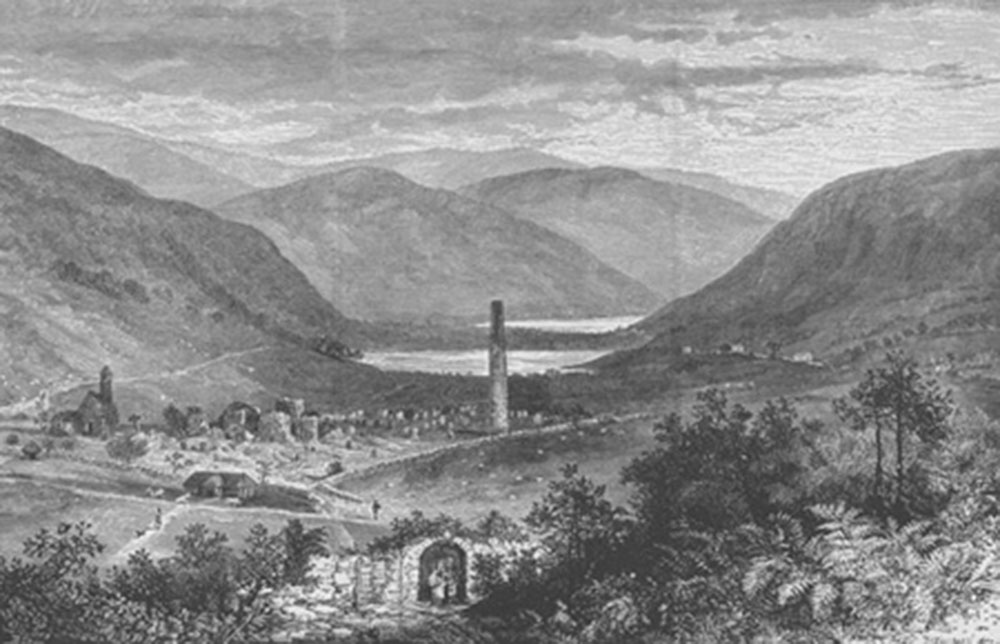Vale of Glendalough, County Wicklow - Irish Pictures (1888)
From Irish Pictures Drawn with Pen and Pencil (1888) by Richard Lovett
Chapter II: The Garden of Ireland … continued
« Previous Page | Start of Chapter | Book Contents | Next Page »
Shortly after passing this church, the Vale of Glendalough comes into sight, and presents on a fine day one of the most beautiful pictures that the 'Garden of Ireland' can show. To the right is the Vale of Glendasan, to the left Glendalough; a mountain juts out boldly to a well-defined edge, separating the two valleys, and in the distance are clearly seen the mountains that shut in the upper end of the valley. If the visitor is driving it is customary to take him up to the western end of the valley, by the shores of the upper lake, and leave him to explore the beauties and antiquities of that region, and then walk down again to the cashel. By these shores St. Kevin, the founder of the first ecclesiastical buildings erected here, lived his hermit life. The saint is an undoubtedly historical character, and flourished in the early part of the sixth century. The facts seem to be that he built the cell on the south shore of the lake, known as Tempul-na-skellig, also part of the building known as St. Kevin's Kitchen, and that he lived for years in the vale; but as usual legend has been very busy with his name. Once when the saint, according to his habit, extended his hand from the window of his cell in the attitude of supplication, a blackbird dropped her eggs into it. He never altered the position, hand or arm, until the eggs were hatched! It was by these lakes that King O'Toole, when too old to hunt, used to amuse himself by watching his geese swim. Great was his grief when his favourite gander became too old to fly. To him comes the saint, 'What will you give me if I make him fly again for you?' 'Why, I'll give you all the ground he flies over, even suppose he flew round the whole glen.' With that exactness always noticeable on these occasions, the gander did fly round the whole glen. 'Now,' said the saint, 'King O'Toole, be as good as your word, give me this place, and I will dedicate it to God.' And King O'Toole, 'putting a handsome face on it,' made over the valley for ever and a day to the enterprising saint.
The savage side of asceticism, and its unnatural violation of the duties and claims of ordinary life, are illustrated by the legend of Kathleen. To escape from her affectionate entreaties, the saint fled to the hole in the cliff overhanging the upper lake, up to which tourists occasionally climb, undergoing thus needless risks, to the enrichment of the wily boatmen and guides. But the saint's hopes of peace were vain. Even here Kathleen found him.
Fearless she had tracked his feet,
To this rocky wild retreat!
And when morning met his view,
Her mild glances met it too.
Ah! you saints have cruel hearts!
Sternly from his bed he starts,
And with rude repulsive shock,
Hurls her from the beetling rock.
That such a legend could be told, as it undoubtedly was, to the saint's credit, is but one of manifold proofs that a too exclusive and mistaken notion about the salvation of one's own soul may lead to extraordinary callousness as to the rights of others, and the claims of mercy. But St. Kevin is not responsible for the foolish legends that have centred about his personality. To him belongs whatever credit is due for the foundation of an ecclesiastical establishment at Glendalough. Later generations extended and developed his work.
« Previous Page | Start of Chapter | Book Contents | Next Page »

